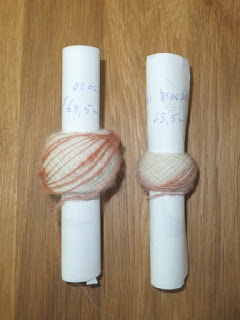Yesterday afternoon, I got to have half an hour of quality time with my favourite hand-spindle - one of my spindle sticks and a whorl that I bought somewhere, ages ago, and that remains my firm favourite for about any hand-spindle spinning tasks I get.
The results? Half an hour of concentrated spinning with spindle (and distaff, naturally, need I even mention that?) yielded 23.5 metres of worsted yarn.
Here's the two little balls of yarn side by side:
Next up: doing the same with my treadled spinning wheels...
The results? Half an hour of concentrated spinning with spindle (and distaff, naturally, need I even mention that?) yielded 23.5 metres of worsted yarn.
Here's the two little balls of yarn side by side:
Next up: doing the same with my treadled spinning wheels...




